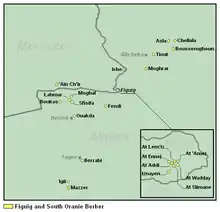South Oran and Figuig Berber
South Oran Berber, or Figuig Berber (Figig), is a cluster of the Zenati languages, which belong to the Berber branch of the Afroasiatic family.[4] It is spoken in a number of oases of southwestern Algeria and across the border in Morocco.
| South Oran and Figuig Berber | |
|---|---|
| tašəlḥit, tabəldit | |
| Native to | Algeria, Morocco |
| Region | Ksour Mountains, Saoura basin, Figuig region |
Native speakers | 61,000 in Algeria (2008)[1] 20,000 to 30,000 in Morocco (2011?)[2] |
Afro-Asiatic
| |
| Arabic, Latin, Tifinagh | |
| Language codes | |
| ISO 639-3 | None (mis) |
qb8 Figuig | |
| Glottolog | sout3056 South Oran |
| ELP | Figuig[3] |
 | |
These areas include most of the ksour (fortified villages) between Mecheria and Béni Abbès: Tiout, Ain Sfisifa, Boussemghoun, Moghrar, Chellala, Asla, Fendi, Mougheul, Lahmar, Boukais, Sfissifa, Ouakda, Barrbi near Taghit, Igli, Mazzer in Algeria, Iche, Ain Chair and the seven ksour of Figuig (Ait Wadday, Ait Amar, Ait Lamiz, Ait Sliman, Ait Anaj, Ait Addi and Iznayen)[2] in Morocco.[5]
Of these towns, the only one whose dialect has been studied in any detail is Figuig (Kossmann 1997).[6] A cursory study of the northern dialects, including texts and vocabulary, is Basset (1885),[7] while a sketch grammar of its southernmost member, Igli, is provided by Kossmann (2010).[8]
Like many other Berber varieties, the Figuig Berber dialects use bipartite verbal negation. The preverbal negator is ul (locally un, il); the postverbal negator is ša (Igli, Mazzer) / šay (Figuig, Iche, Moghrar) / iš (Boussemghoun, Ain Chair), with both the latter two appearing as allomorphs in Tiout.[9] The numerals 1 and 2 are Berber, while higher numerals are Arabic borrowings throughout.[10]
References
- http://www.tlfq.ulaval.ca/axl/afrique/algerie-1demo.htm
- http://www.unesco.org/culture/languages-atlas/en/atlasmap/language-id-2215.html
- Endangered Languages Project data for Figuig.
- This language has no established name in English; in French literature it is referred to as Kçours du Sud-Oranais or parlers des Kçours Oranais et de Figuig, and its speakers mostly call it by the vague term Shelha or Tashelhiyt.
- André Basset, La langue berbère dans les territoires du sud, Revue Africaine vol. 85, 1941, pp. 62-71
- Maarten Kossmann, Grammaire du parler berbère de Figuig: Maroc oriental, Peeters 1997
- René Basset: "Notes de lexicographie berbère 3e série : dialecte des k'çours oranais et de Figuig" in Journal Asiatique 1885 t. II pp. 302-371
- Maarten Kossmann, "Grammatical notes on the Berber dialect of Igli (Sud oranais, Algeria)", in ed. D. Ibriszimow, M. Kossmann, H. Stroomer, R. Vossen, Études berbères V – Essais sur des variations dialectales et autres articles. Köln: Rüdiger Köppe, 2010.
- Kossmann, op. cit.:94
- Kossmann, op. cit.:84